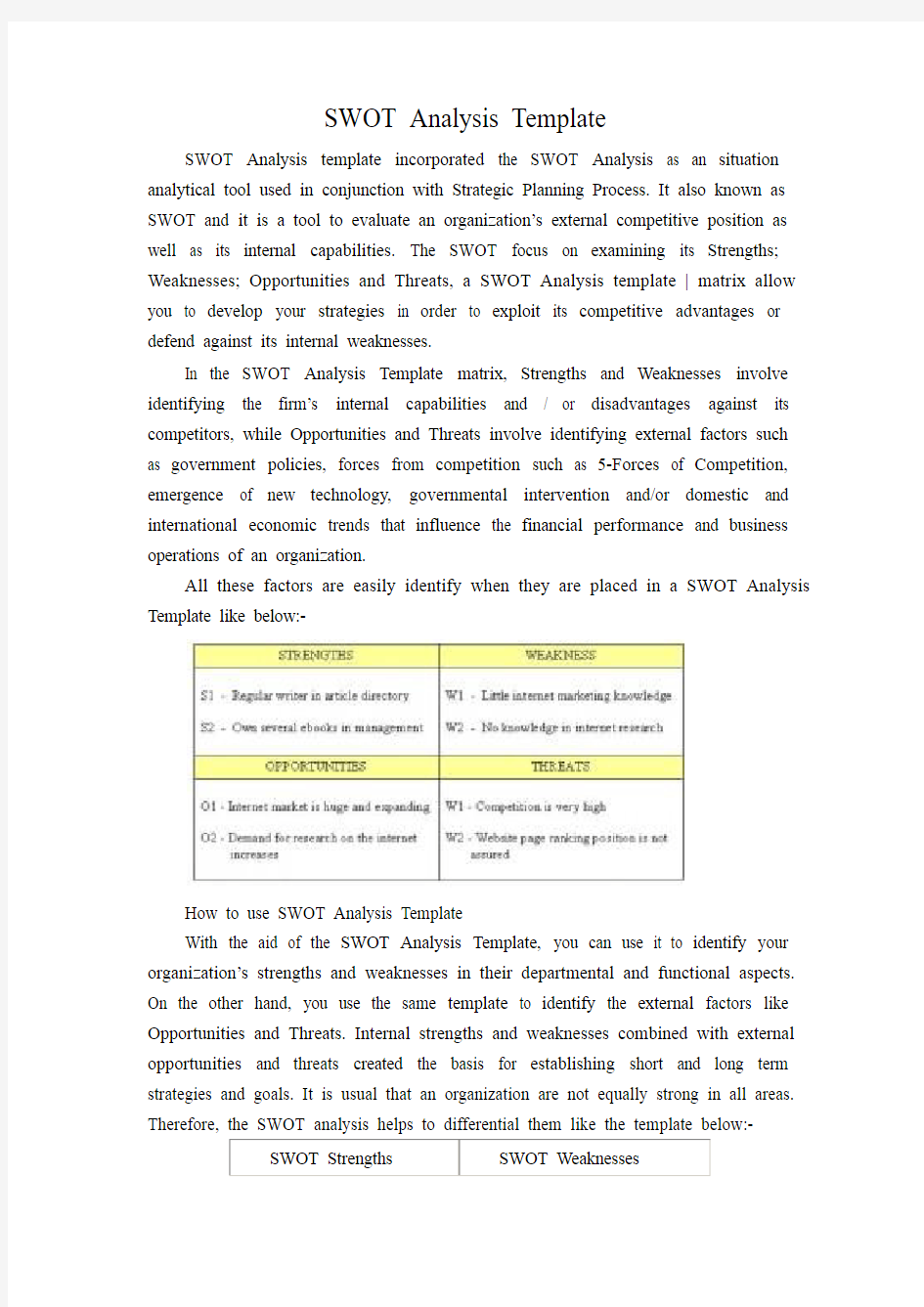SWOT Analysis Template


SWOT Analysis Template
SWOT Analysis template incorporated the SWOT Analysis as an situation analytical tool used in conjunction with Strategic Planning Process. It also known as SWOT and it is a tool to evaluate an organization’s external competitive position as well as its internal capabilities. The SWOT focus on examining its Strengths; Weaknesses; Opportunities and Threats, a SWOT Analysis template | matrix allow you to develop your strategies in order to exploit its competitive advantages or defend against its internal weaknesses.
In the SWOT Analysis Template matrix, Strengths and Weaknesses involve identifying the firm’s internal capabilities and / or disadvantages against its competitors, while Opportunities and Threats involve identifying external factors such as government policies, forces from competition such as 5-Forces of Competition, emergence of new technology, governmental intervention and/or domestic and international economic trends that influence the financial performance and business operations of an organization.
All these factors are easily identify when they are placed in a SWOT Analysis Template like below:-
How to use SWOT Analysis Template
With the aid of the SWOT Analysis Template, you can use it to identify your organization’s strengths and weaknesses in their departmental and functional aspects. On the other hand, you use the same template to identify the external factors like Opportunities and Threats. Internal strengths and weaknesses combined with external opportunities and threats created the basis for establishing short and long term strategies and goals. It is usual that an organization are not equally strong in all areas. Therefore, the SWOT analysis helps to differential them like the template below:-
SWOT STRENGTHS
The strengths of your organization if realized, would able to provide a comparative advantage against its competitors. However, you need to identify the SWOT Strengths that are relative to the competitors. Its internal strengths that cannot be matched or imitated by competitors are widely referred to as distinctive core competencies.
Generally, perceived strengths that build competitive advantages by exploiting distinctive competencies can include emerged brand name, market leadership, excellent customer service resulted in customer loyalty, superior quality products, innovative Research & Development, , and/or strong financial resources. To remain as a SWOT Strengths, they must continue to be developed, maintained and defended. This can be represented in a SWOT Analysis Template
.
SWOT WEAKNESSES
The SWOT weaknesses of your organization refers to a situation when your competitors have potentially advantages over you in their capabilities such as deliveries, profit margin, market spread, customer base etc. Generally, a perceived internal weaknesses may include negative images / reputation, poor quality products, long lead time, poor delivery, incompetent marketing personnel, slow responsive customer service, inconsistent vendor support, poor financial management.
These are examples of Weaknesses that has direct impact to the customers hence the revenue and it should take priority over the rest of weaknesses. You should include Weaknesses derived from your own operation analysis. Once it is done, you put them in the right quadrant of the SWOT Analysis Template shown.
SWOT OPPORTUNITIES
In SWOT Analysis, an external Opportunities is referred to an external environmental factors that provide additional venue to increase revenue ( so is to your competitors as well). It is normal an unknown factors and only based on certain assumptions. These perceived opportunities may include an include a growing market segment, acquisition and mergers, joint ventures and strategic alliances with others players.
Included in this SWOT Opportunities factor are the positive aspects of external forces changes consumer behavior that can derive from PEST Analysis such as economic situation, social and cultural aspect, demographic changes, political and governmental stability, technological changes and competitive forces, example: Michael Porter 5-Forces of Competition. The SWOT Analysis Template aid to put all these factors into proper perspective in the template itself.
SWOT THREATS
External Threats are environmental factors that can hinder you in achieving your business objectives and goals. Generally, perceived threats can include the entrance of new competitors directly or indirectly, erosion of profit margin due to price wars, impending negative legislation, buyers market, suppliers form informal cartel seek to increase their bargaining power, emergence of new technology could made your product obsolete, Introduction of innovative products by competitors, competitors open more new sales channels, change of tax structure, removal of incentive schemes etc.
Include the negative aspects of external forces changes consumer behavior that can derive from PEST Analysis such as economic situation, social and cultural aspect, demographic changes, political and governmental stability, technological changes and competitive forces, example: Michael Porter 5-Forces of Competition. You can see more SWOT example here
.
SWOT Analysis Template
In summary, with the aid of a SWOT Analysis Template, a holistic SWOT analysis should realistically conducted and take advantage of Opportunities with your
strengths and to reduce the impact of Threats with Strengths. At the same time, a focused program to put in place to improve any Weaknesses that could mitigate the potential Threats. Finally, SWOT Analysis should always be applied in relation to competition to offer a comparative analysis of your organization and your competitors. Use the SWOT Analysis Template to guide you to identify all these SWOT Factors. Be creative to modify the SWOT Analysis Template to suit your needs as long as it capture all the four SWOT factors.
